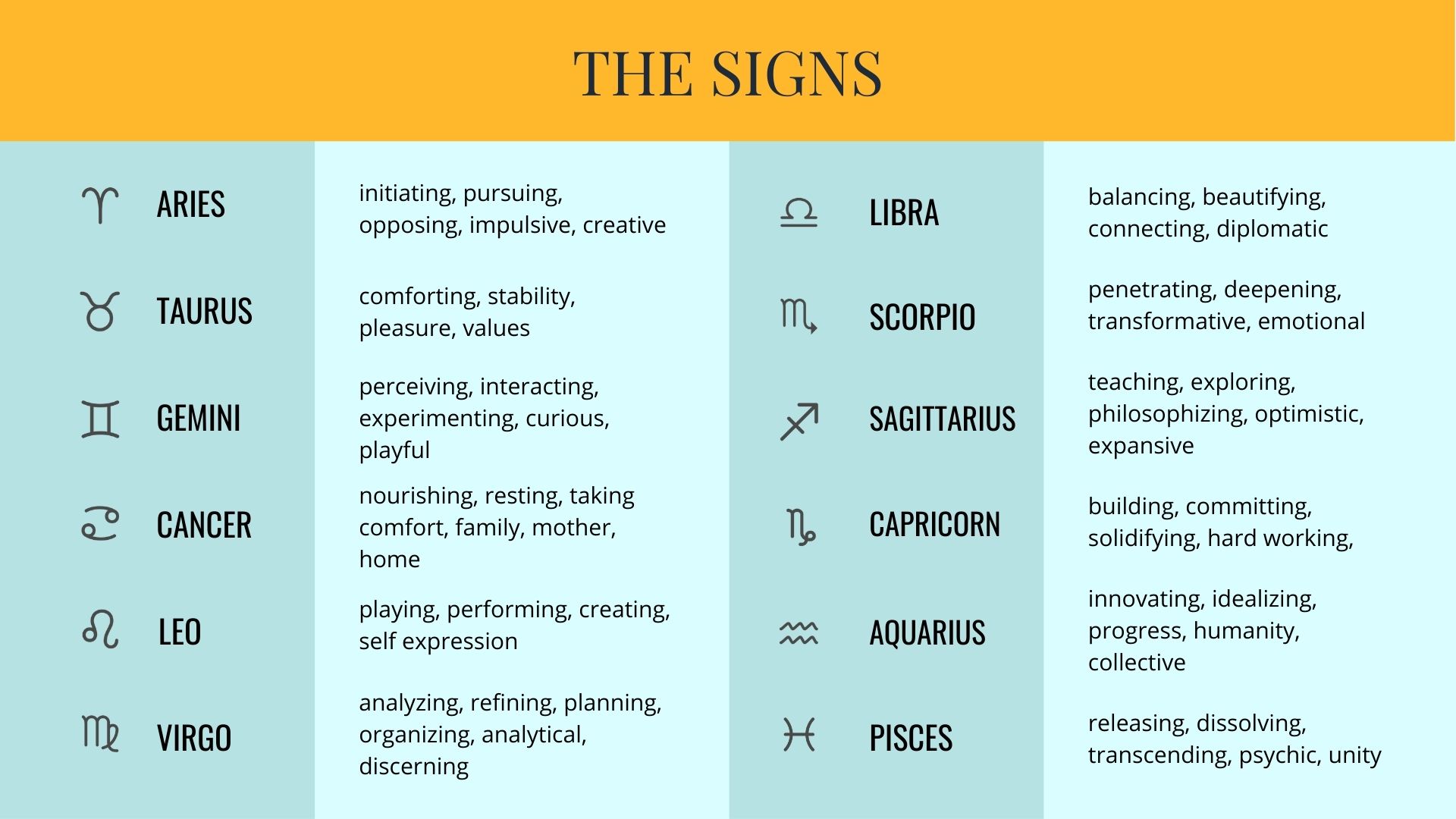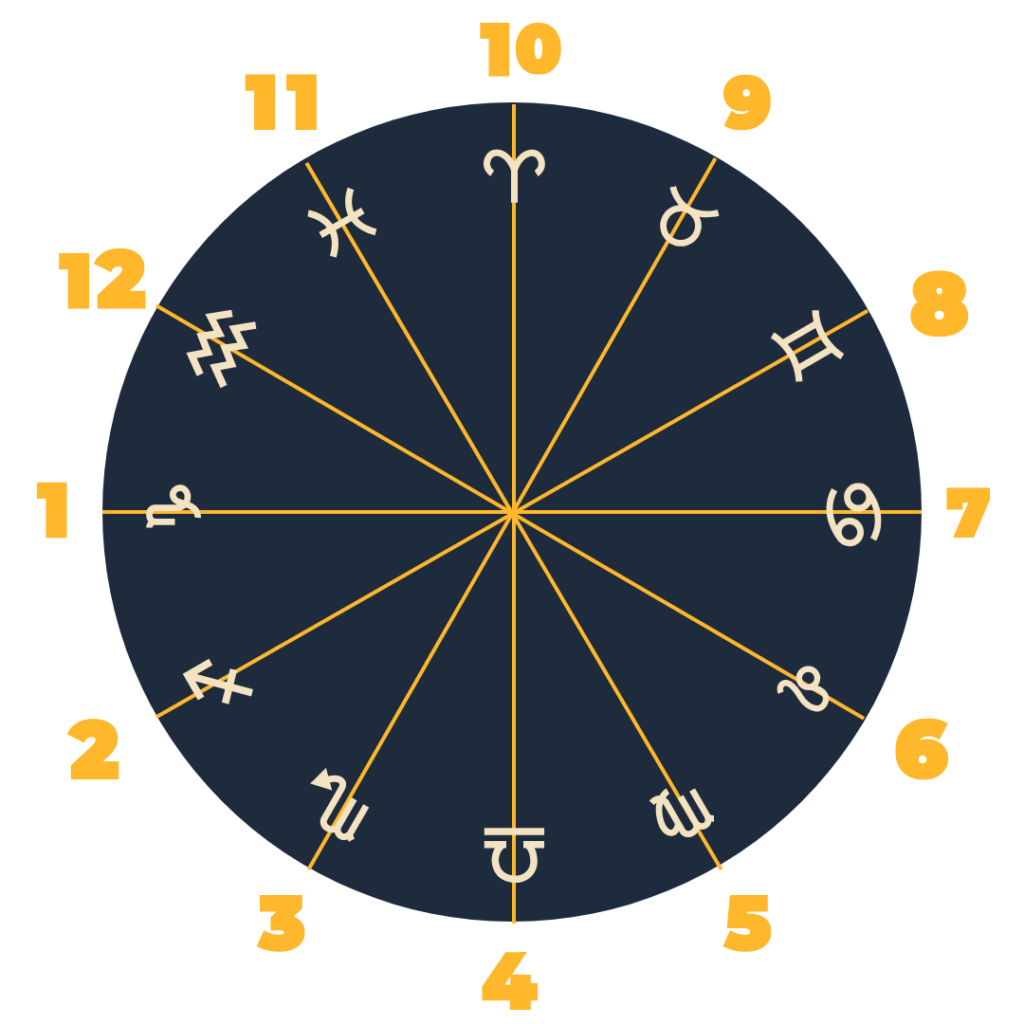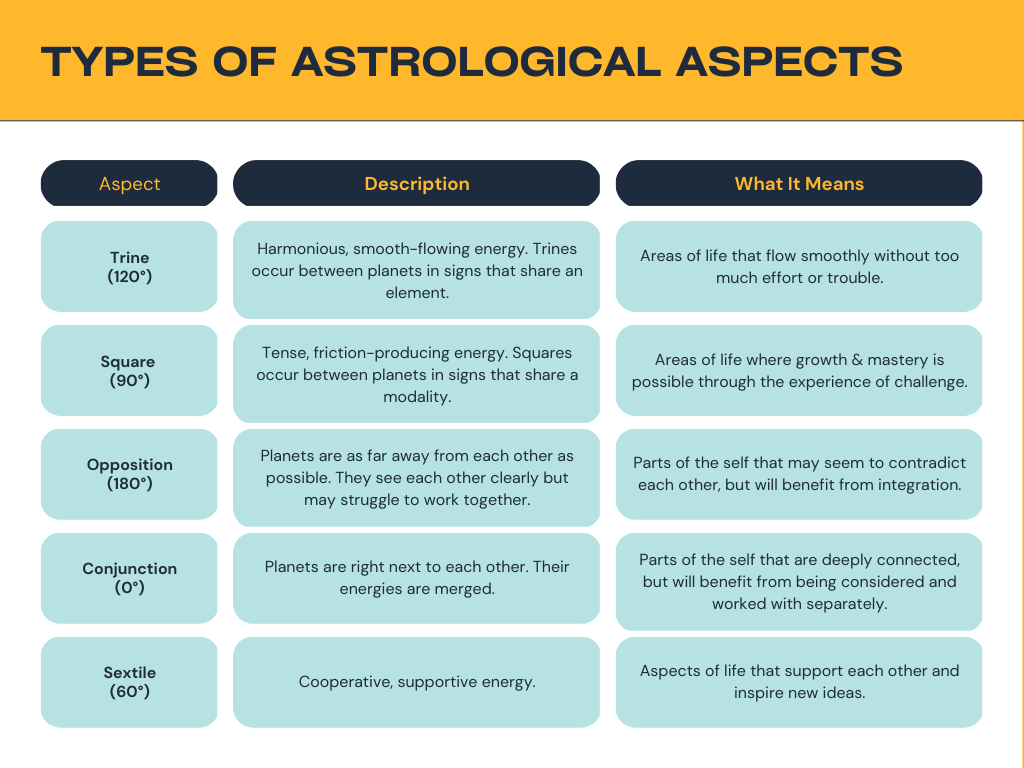How to Read an Astrology Chart
Reading astrology charts is a complex art form that people spend years, even decades, studying and practicing in order to master. Astrology charts are maps of the sky that describe a particular moment in time. They contain the secret codes to your unique blueprint and your path of personal growth, hidden in the language of astrology! Read on to learn:
1. The Parts of the Chart
-
- The Signs in an Astrology Chart
- The Planets in an Astrology Chart
- The Houses in an Astrology Chart
- The Aspects in an Astrology Chart
2. Putting it All Together: Interpreting the Chart
-
- Birth chart interpretation
- Understanding the chart ruler & patterns
- Using the chart ruler & patterns to interpret the chart
3. More Resources
-
- Recommended online resources & classes
- Chart analysis software and tools
- Finding a mentor or community to study with
4. Conclusion
PARTS OF THE CHART
To begin reading an astrology chart, you’ll need to understand the different parts of the chart. Most charts are drawn as a circle and depict the zodiac wheel. This wheel is also called the ecliptic, which is the path the Sun and the rest of the planets take around the sky from the perspective here on Earth.
The ecliptic is broken up into the twelve signs of the zodiac. You could consider these like the numbers around the edge of a clock: they represent spaces in time that the planets, like the hands of the clock, pass through.
A natal chart is a map of where all the planets were in the sky the moment someone was born. This is your cosmic thumbprint! No two people have the same chart, even twins!
The trick to learning how to read astrology chart means understanding the language it’s written in. There are three essential components of this language: the zodiac signs, the planets, and the houses.
We’ll break down each of these elements further, but if you think of your life as a movie, the planets are the actors, the signs are the costumes they wear, and the houses are the set and setting of the scene.
The Zodiac Signs
The signs of the zodiac make up the entire natal chart wheel. The signs give your chart a personality, preference and unique needs. For example, Taurus values comfort, stability and pleasure, whereas Scorpio values depth, emotions, and control. As planets travel through these spaces in time, these preferences and desires will become apparent.
Each sign is one of the 4 elements, which makes some signs more similar to others.
- Fire Signs (Aries, Leo, Sagittarius): creative, impulsive, energetic signs
- Earth Signs (Taurus, Virgo, Capricorn): hard-working, practical, organized, grounded
- Air Signs (Gemini, Libra, Aquarius): innovating, thoughtful, intellectual, connecting
- Water Signs (Cancer, Scorpio, Pisces): emotional, empathetic, reflective, psychic
As you continue learning about astrology through practice and study – and reading lots of birth charts – you’ll begin to build your own relationship with them. But for now, here are a few keywords for each star sign to get you started.

You’ll notice the symbol in front of each of the signs. This is called a glyph. It’s important to get familiar with these glyphs and memorize them.
The Planets
Every astrological chart contains all twelve zodiac signs, but not every sign will have a planet placed within it. The Sun sign, which most people are already familiar with, is the sign where the Sun is located in the chart, and it indicates the energy that radiates from within the person, which other people can see and appreciate. The Moon sign represents the person’s emotional landscape, how they experience and process their feelings.
The Sun and Moon are known as luminaries. Mercury, Venus, Mars, Jupiter and Saturn are called the inner planets. Uranus, Neptune and Pluto are the outer planets.
Each planet will represent and govern a different aspect of a persons personality or internal world.
Here are a few keywords for each.

The Houses
If the signs are the costume, and the planets are actors, then the houses are the set and setting where the action plays out.
The chart circle is divided into 12 houses, which correspond to the signs but are not the same. Each house has a cusp, or a point in the chart where one house ends and the next one begins. Each of those cusps will be located within a particular sign so, the sign that the cusp is located in is the sign that will be most associated with that house.

In this example, the first house cusp (which is also referred to as the ascendant or rising sign) is located in Capricorn. That means that Capricorn energy will be flavoring the entire first house, and any other planets that are placed there.
Here are a few keywords for what area of life each house corresponds to:
- 1st House: body, physical appearance, outward-facing identity
- 2nd House: money, values, self-worth, wealth
- 3rd House: neighborhood, siblings, pets, short trips, errands
- 4th House: home, family, ancestors, lineage, private life
- 5th House: sex & romance, creativity, children, hobbies, self-expression
- 6th House: work life, health, daily routines, day job
- 7th House: 1-1 relationships (both intimate and professional), contracts, open enemies
- 8th House: commitment, taboo subjects, shared finances, legal issues, inheritance
- 9th House: travel, higher education, philosophy, foreign affairs
- 10th House: career, social role, reputation, public persona
- 11th House: friends, community, tribe, hopes and dreams for the future
- 12th House: spirituality, secrets, psychic abilities, hidden enemies, addiction
The Aspects in an Astrology Chart
In order to truly read a birth chart, you need to understand all of these pieces and how they fit together. You’ll also need to understand the different relationships between the planets in the chart, known as aspects.
If we continue with our analogy of your life as a movie, you can see the planetary aspects as the dialogue that’s happening between the planets.
Planets form aspects when they connect across the circle at certain angles. There are many, many different aspects planets can form, but here are a few of the most common ones.

PUTTING IT ALL TOGETHER: INTERPRETING THE BIRTH CHART
Understanding how all of these elements work together in a birth chart is a lifelong practice and study for astrologers. There are many, many different styles and methods of chart interpretation including synastry, composite charts, horary, electional and natal astrology. This article is focused on natal astrology, or the study of birth charts. Even within that category, there are a variety of different approaches that emphasize different aspects of the chart and the person’s life. These include:
- Evolutionary astrology, which tracks a soul’s evolution across lifetimes
- Modern astrology, which has a more psychological focus
- Traditional astrology, which has roots in Hellenistic or Medieval forms of astrology and tends to focus on prediction over psychology
- Vedic astrology, which originates in ancient India and uses a sidereal calendar
- Locational astrology, which uses the birth chart to determine a person’s relationship with different places
Understanding the Chart Ruler and Patterns
Every sign has a ruling planet, and the ruler of the chart is typically said to be the ruler of the sign on the cusp of the first house, also known as the ascendant. This planet will have a special emphasis in the chart, so it’s particularly important to pay attention to the sign this planet falls in and any aspects that it makes.
Some planets have multiple rulers because of the discovery of Uranus, Neptune and Pluto. Below is a list of all planetary rulers. Notice how there are similar qualities between the Zodiac Sign and it’s Planetary ruler.
- Aries: Mars
- Taurus: Venus
- Gemini: Mercury
- Cancer: The Moon
- Leo: The Sun
- Virgo: Mercury
- Libra: Venus
- Scorpio: Pluto (modern ruler), Mars (traditional ruler)
- Sagittarius: Jupiter
- Capricorn: Saturn
- Aquarius: Uranus (modern ruler), Saturn (traditional ruler)
- Pisces: Neptune (modern ruler), Jupiter (traditional ruler)
Using the Chart Ruler & Patterns to Interpret the Chart
The first thing that many professional astrologers will look at in a birth chart is the chart ruler. Identify the zodiac sign that is on the ascendant and then find the planet that rules that sign. What sign is that planet in? What house? Is it involved in any conversations with different planets? This will give you a lot of information about the chart.
The next thing that often jumps out to an astrologer is the aspect patterns we’ll explore next. Because these patterns often involve multiple placements and conversations, looking at them first can provide a much better understanding of the chart's overall tone.
Aspect Patterns
Sometimes one or more planets form multiple aspects, creating shapes or patterns in the chart. Each of these patterns has a special meaning. A professional astrologer can tell you more, but for now, here are a few common chart patterns you might encounter.
Grand Trine
Grand trines are patterns formed when three planets each form an aspect with each other in signs that share an element. For example, if you have planets in each of the Earth signs and they are trining each other, you have a grand trine in Earth. You will know if you have a grand trine by looking at your chart and seeing if there is an equilateral triangle drawn between any three planets.
Grand trines in a birth chart tend to indicate that the individual will experience a sense of ease in matters relating to that element.
A grand trine in Earth, for example, indicates a person with an aptitude for money and practical concerns. In water, the grand trine indicates someone whose emotional life flows freely. In air, someone with a grand trine may find it easy to communicate their thoughts, and in fire, the grand trine indicates that motivation for action is readily available.
T-Square
T-Squares are also triangles, but they look like a right triangle rather than an equilateral one. A T-Square is formed by two 90° squares and one 180° opposition.
This is a tense aspect pattern that tends to describe a persistent challenge in a person’s life. This material is meant to be worked with in order to heal and grow through the experience of challenge. In time and with practice, what was very difficult for a person can become easy as they build their skills and capabilities. T-square inspire action in the native, and will require all 3 planets to find compromise.
Grand Cross
A grand cross consists of two T-squares placed together to form a square. There will be two oppositions that cross each other at a 90° angle, forming squares between the planets involved in one opposition and the planets involved in the other. In the chart, this will look like a complete square.
Having a grand cross in your astrology birth chart will indicate a significant and ongoing tension between the planets involved. They may seem to be working at cross-purposes and need to be integrated with each other in order to relieve some of the stress. This indicates a significant amount of personal growth that may take place during your lifetime, and a path for healing your inner self. Don’t worry if you have this in your birth chart, though! Tense aspects are often what creates highly creative, innovative and resilient people.
More Resources
Recommended online resources & classes
The Astrology Hub Academy is full of opportunities for you to build upon this basic foundation and learn how to read the intricacies of natal charts, transit charts, synastry charts and more. We offer classes that can support your developing life path, help you understand your personality and build your astrology technique. Astrology is truly an endless subject with seemingly infinite different styles, approaches, techniques and uses. Browse our library of courses to open up a new world of learning!
Chart Analysis Software and Tools
Many beginners start by using AstroDienst (astro.com) to store their birth details and view their birth chart, solar return charts or other events. This free website offers quite a bit of customization and is more than adequate for most non-professionals.
But if you're considering becoming a professional astrologer, you will want to invest in a more powerful software such as SolarFire or AstroGold. You can learn more about these tools on their websites, but both of them have the advantage of allowing you to progress forward and backward through time, watching the movements of the planets at each exact moment.
Finding a Mentor and Community to Study With
For most budding astrologers, working with at least one teacher and a group of peers is absolutely key. Just like learning a foreign language, real-life practice and conversation is one of the best ways to become fluent. Astrology Hub's Inner Circle is a great way to connect with a supportive learning community and experience learning with a new astrologer every month!
If you want to learn astrology in a structured container at your own pace, the Inner Circle is a fantastic resource! Click here to learn more.
Conclusion
The study of astrology is a lifelong pursuit of wisdom and growth. This is just the beginning of your journey! We hope that this brief primer has helped you identify a few areas you'd like to learn more about, and we encourage you to check out our Academy to keep learning!


